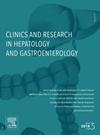西班牙裔肝细胞癌患者的护理可及性和西班牙裔悖论
IF 2.6
4区 医学
Q2 GASTROENTEROLOGY & HEPATOLOGY
Clinics and research in hepatology and gastroenterology
Pub Date : 2025-02-01
DOI:10.1016/j.clinre.2024.102519
引用次数: 0
摘要
目的:尽管肝细胞癌(HCC)对西班牙裔患者的影响不成比例,但报道的结果有限,特别是在亚人群中。我们的研究旨在评估西班牙裔亚人群在获得护理和生存方面的结果。方法:然后利用国家癌症数据库识别2004年至2020年间诊断为HCC的患者。感兴趣的自变量是种族/民族群体,西班牙裔人口按种族和西班牙裔血统分类。主要结果是早期和晚期HCC的表现,正在进行治疗意图的手术,治疗时间和总生存期。对人口统计学、临床和社会经济变量进行调整后进行Logistic回归。结果:在确诊的211988例HCC患者中,12.3% (n=26,085)被归类为西班牙裔。与NHW患者相比,南美/中美洲患者出现早期症状的几率最低(OR=0.91;p=0.1),古巴患者接受治疗目的手术的几率最低(OR=0.72;p=0.04),墨西哥患者延迟治疗的几率最高(OR=1.45;讨论:尽管切除率降低,延迟治疗的可能性增加,但与NHW患者相比,西班牙裔患者在其亚群中生存率提高,进一步突出了西班牙裔悖论。本文章由计算机程序翻译,如有差异,请以英文原文为准。
Access to care and the Hispanic paradox among Hispanic patients with hepatocellular carcinoma
Purpose
Despite the disproportionate impact of hepatocellular carcinoma (HCC) on Hispanic patients, reported outcomes are limited, particularly among subpopulations. Our study aimed to evaluate outcomes in access to care and survival among racial and ethnic Hispanic subpopulations.
Methods
The National Cancer Database was utilized to identify patients diagnosed with HCC between 2004 and 2020. The independent variables of interest were racial/ethnic groups, with the Hispanic population disaggregated by race and Hispanic heritage. The primary outcomes were the presentation of early versus late-stage HCC, undergoing a curative-intent procedure, time to treatment, and overall survival. Logistic regression was performed with adjustments made for demographic, clinical, and socioeconomic variables.
Results
Among 211,988 patients with HCC identified, 12.3 % (n = 26,085) were classified as Hispanic. In comparison with NHW patients, South/Central American patients had the lowest odds of early-stage presentation (OR=0.91; p = 0.1), Cuban patients had the lowest odds of undergoing a curative-intent procedure (OR=0.72; p = 0.04), and Mexican patients had the highest odds of delayed treatment (OR=1.45; p < 0.001). Hispanics had a longer median survival at 19 months than NHW patients (15 months, p < 0.001), with Hispanic Black (HR 0.59, p < 0.001) and Dominican (HR 0.56, p < 0.001) patients having the lowest mortality risk among Hispanic subpopulations.
Discussion
Despite decreased resection rates and increased likelihood of delayed treatment, Hispanics had improved survival across its subpopulations in comparison to NHW patients, further highlighting the Hispanic paradox.
求助全文
通过发布文献求助,成功后即可免费获取论文全文。
去求助
来源期刊

Clinics and research in hepatology and gastroenterology
GASTROENTEROLOGY & HEPATOLOGY-
CiteScore
4.30
自引率
3.70%
发文量
198
审稿时长
42 days
期刊介绍:
Clinics and Research in Hepatology and Gastroenterology publishes high-quality original research papers in the field of hepatology and gastroenterology. The editors put the accent on rapid communication of new research and clinical developments and so called "hot topic" issues. Following a clear Editorial line, besides original articles and case reports, each issue features editorials, commentaries and reviews. The journal encourages research and discussion between all those involved in the specialty on an international level. All articles are peer reviewed by international experts, the articles in press are online and indexed in the international databases (Current Contents, Pubmed, Scopus, Science Direct).
Clinics and Research in Hepatology and Gastroenterology is a subscription journal (with optional open access), which allows you to publish your research without any cost to you (unless you proactively chose the open access option). Your article will be available to all researchers around the globe whose institution has a subscription to the journal.
 求助内容:
求助内容: 应助结果提醒方式:
应助结果提醒方式:


